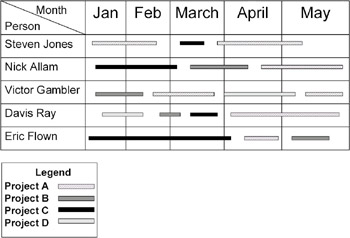What are the tools and rules for human resource coordination in projects?
|
As mentioned before, the normal project-oriented environment is often extremely complicated from the viewpoint of the organizational structure. In order to decrease the degree of confusion and argument, the project managers have to undertake every effort possible in order to apply some structure to human resource distribution and coordination between different projects and operational activities of the functional departments.
There are a number of simple but useful instruments used by project managers and a number of rules project managers have to follow in a project-oriented organization in order to make the overall project organization more transparent and satisfactory to various project stakeholders.
Tell me more …
Staffing plans are used by functional managers in order to be able to track different employees from project to project. As shown in Figure 6-4, a staffing plan is a simple matrix showing the projects each person is working on at certain periods of time. Functional managers can use the staffing plan in order to see the people available to fulfill certain functional or new project jobs; it also gives the person himself some vision of his coming assignments.

Figure 6-4: STAFFING PLAN
The responsibility-accountability matrix in Figure 6-5 is a tool used in some format in projects almost everywhere. Normally it is a matrix table representing a group of people and showing their role and/or responsibility related to certain tasks or groups of tasks. Any types of symbols and signs can be used in order to make the scheme clearest.
| Person | Task | Overall planning | Database development | Survey development | Survey implementation | Result evaluation and reporting |
|---|---|---|---|---|---|---|
| Steven Jones | P | R | P | P | P | |
| Nick Allam | P | P | R | R | P | |
| Victor Gambler | P | P | A | A | P | |
| Davis Ray | R, S | S | S | S | R, S | |
| Eric Flown | A | — | P | — | A | |
R-Responsible A-Assists P-Participates S-Sign-off
Figure 6-5: RESPONSIBILITY-ACCOUNTABILITY MATRIX
In any project, regardless of its size and complexity, it is absolutely essential that an organizational chart be developed for the project showing the names, positions, and responsibilities of the project team members and often other important project stakeholders. The organizational chart can easily correspond to the project WBS where the subproject managers are assigned to certain work groups or subprojects in the structure of the WBS. The organizational chart for the project gives the project stakeholders, as well as the people outside of the project, the opportunity to find the person they need in the overall project structure.
In strong matrix organizations, many people spend months at a time without ever seeing their functional departments, moving from one project to another. In this case, especially considering the fact that it is normally outside of the scope of the project manager's responsibilities to take care of salary levels, career advancements, training needs, etc., of certain team members, it becomes critically important that the communications between the project manager and the functional manager are efficient and reliable. The project manager in this case becomes responsible for relaying information about team members' performance on the project to the functional managers, who are then able to use this information and the information from other projects to make yearly decisions on the employees' career development, salary changes, etc.
|
EAN: 2147483647
Pages: 126